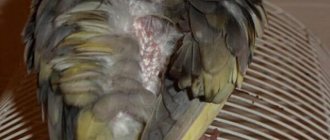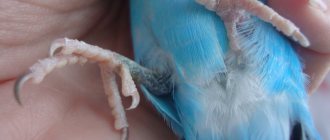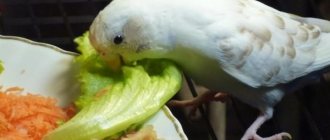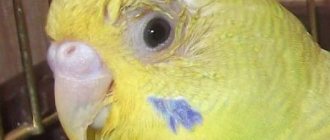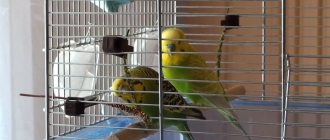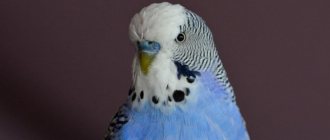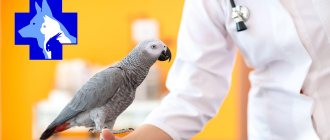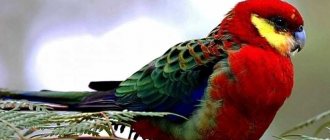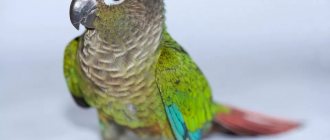Communication with a pet parrot is not only a charge of positivity and serenity, but also dozens of new discoveries. One of the many questions that may alarm the owner is why the parrot often tucks its paw under itself. In some cases this is not a problem. How to determine whether there is a reason for concern and whether something needs to be done about it, you will learn by reading the article.
Communication with the owner
If you notice the symptom in question, do not panic. The reason may lie in the bird’s banal desire to communicate with its owner. You need to watch your pet. If the parrot behaves as usual in the absence of the owner, and when he appears, he raises one paw, clenching his fingers into a fist, this means greeting. The bird is simply happy to see its breadwinner and feels protected with him.
Did you know? The budgerigar is very savvy. He is able to learn from 100 to 150 human words.
Many birds of this species like to bend one leg while singing. This looks comical and there is no reason to worry. In addition to the above, it is worth taking into account the character traits of these birds. They have a changeable mood: now the pet can have fun, play and chirp, and a minute later it will sit down, ruffled, and press its paw. This may mean that the bird has decided to rest. Some “wavy cats” like to sleep at the bottom of the cage or right on the table.
The main thing for the owner is not to panic ahead of time, but to be able to observe the behavior of the bird.
How to tell if a parrot is cold
The budgerigar comes from Australia, where the subtropical climate prevails. The weather there is hot and humid, and therefore the bird does not tolerate the cold particularly well. The optimal temperature at which a parrot will feel normal in an apartment is +18...+22°C. If these indicators decrease or there is a draft, the bird freezes. Accordingly, it instinctively tries to warm its limbs, alternately pressing its paws to its tummy and hiding them in warm feathers.
We invite you to find out how to choose a healthy budgie for your home.
A number of other symptoms will confirm that your pet is cold:
- fluffy plumage and tufting;
- possible refusal of food;
- low activity;
- drooping eyelids or severe bulging of the eyes;
- lack of reaction to loud sounds.
The situation must be corrected immediately, otherwise the pet may get sick and even die.
This can be done by wrapping the cage in a warm blanket and moving it to the highest point in the house. You can also place an incandescent lamp near the parrot’s housing. The bird can be placed in a warm woolen sock. When getting yourself a feathered friend, you should immediately think about buying a thermal mat, which is placed at the bottom of the cage and connected when the house is cold.
Initial examination
To understand whether a parrot's behavior is normal, you need to observe it in different situations. It is necessary to find out under what circumstances and how the pet presses its paw, what it feels:
- Only during sleep or throughout the day is the limb raised. How long does it take to sit on one leg?
- Does the bird take care of only one leg or selects them for itself one by one?
- Is there any pain when standing on your leg?
- Are there any damages (calluses, wounds, swelling, redness).
Important! Observation of a parrot is accompanied by checking the cage and accessories, identifying deficiencies and errors in care.
Injuries
Injury to the lower extremities is a common occurrence among “wavy” people. They may get their paws tangled in their own toys or hit the bars of the cage. In addition, the perch may have an irregular shape or burrs. If the parrot has only one leg bent at all times, and there is also a lack of coordination when walking, the inability to constantly hold its head is a clear sign of injury. The damaged limb may change color to a more intense or bluish color. If there is an injury, the owner should immediately take the bird to a veterinarian.
Important! Do not use brilliant green and iodine to treat scratches and wounds of a budgie. These drugs can leave burns on the bird's body.
Parrots can also get burned. For example, if they fly freely around the house and have access to the kitchen. In this case, as first aid, you should lubricate your pet’s paw with Miramistin or Betadine and go to the doctor. It may happen that when trimming the claws, the owner accidentally harms the pet. If this happens, then to stop the bleeding, you can put a crystal of potassium permanganate on the cut area. Hydrogen peroxide will also help in this matter.
More serious illnesses
Sometimes you can observe how the parrot tucks in, covering only its left paw. Why is this happening? The bird cannot stand on it and moves its limb to the side. This behavior may indicate a malfunction of the digestive system. In this case, it is necessary to review the bird’s diet and analyze the quantity and quality of vitamin supplements. It is important to limit basic nutrition so as not to cause overeating. The bird must be fed according to the standards developed for each individual species of parrot.
A tucked paw may indicate toxic poisoning. In the rooms where the bird has access, there should be no poisonous indoor plants: dieffenbachia, dracaena, milkweed.
On a note. Most house plants are poisonous to birds, so before buying a bird you will have to make a choice only in its favor.
The use of antiparasitic drugs can cause intoxication of the pichuga. It is important to maintain the dosage and follow the doctor's instructions.
Poisoning can also be caused by:
- unboiled water,
- musty litter
- low-quality rotten food,
- oversaturation of the diet with protein.
It is better for smoker owners to give up their addiction and not smoke in the room where there is a pet. Tobacco smog is deadly to him.
When wondering why a seemingly healthy parrot begins to tuck one of its legs, it is important to check the composition of your bird food. To enhance the color of the plumage of exotic birds, the manufacturer adds the substance “xanthaxant” to the food. Over time, it accumulates in the pet’s body and causes intoxication.
On a note. It is better to exclude food containing this chemical from the diet. They cause convulsions and lead to the death of motley birds.
Ulcers
The “wavy” may curl up one paw due to the presence of an ulcer on the foot. The pathology develops as a result of frequent sitting on an uncomfortable perch, lack of movement or stagnation of blood in the limb. The presence of an ulcer can be determined by examination. A parrot's injured leg usually swells and becomes hot. Over time, a wound appears on the foot, which later turns into a purulent ulcer.
Considering that the bird is trying to reduce the pressure on one limb and mainly stands on the second, a lesion with exudate can also form on it. The only solution to the problem is going to the doctor. The specialist selects treatment depending on the stage of development of the pathology. Therapy is carried out using various drugs. In some situations, the only way to help a parrot is through surgery.
Read what paw diseases there are in parrots.
Description
There is no need to worry if the parrot presses its paws one at a time, in this case it is simply resting or warming itself. But if he constantly presses the same limb, then the situation is different. Analyze what could be causing this.
Read also: Why do girls love flowers?
See if the bird steps on its paw. Does it feel like she is in pain? Remember how long ago the symptoms appeared. Take the parrot in your hands and examine its limbs, paying attention to all sections, compare by color and size.
Gout and arthritis
Improper care of the bird or abnormalities in the functioning of certain organ systems can lead to the development of pathologies such as gout and arthritis. The first manifests itself predominantly in older parrots. Gout usually develops as a result of eating food that is unbalanced in protein or due to impaired kidney function. As a result, uric acid stagnates in the tissues and is deposited in the joints.
Manifestations of gout in a parrot:
- squeezing the sore limb;
- the formation of subcutaneous white nodules on the tissues of the legs, which eventually open and ooze fluid;
- the leg swells and becomes hot.
Unfortunately, the disease is incurable. The owner’s actions in this state of affairs consist of visiting a veterinarian and receiving advice on alleviating the pain syndrome in the bird. Maintenance therapy presupposes sufficient intake of vitamin A through food or drink. There is an option to remove subcutaneous nodes using surgical methods. However, this measure only temporarily eliminates tumors. They will appear again soon after the operation.
Arthritis is observed in parrots that are limited in movement and obese. The deviation is accompanied by alternate tucking of the legs, as it is difficult for the bird to maintain its weight. The limbs become swollen and painful. The situation can be corrected through a diet that excludes foods that promote fat deposition. It is better to choose proper nutrition together with your veterinarian. He may also prescribe additional medications or procedures.
Familiarize yourself with the features of caring for budgies at home.
Congenital and hereditary pathologies
Another reason explaining why a bird can stand on one leg is congenital and hereditary pathologies. The problem may manifest itself as a result of improper maintenance or poor nutrition of the parents of a particular individual. Inbreeding (the mating of males and females from the same litter) can also provoke the appearance of sick offspring.
With congenital and hereditary pathologies, the following may be observed:
- deformity - deformation or absence of phalanges of the fingers;
- joint dysfunction;
- violation of the structure of the hips.
The bird can constantly sit or stand on only one limb, because it is painful or uncomfortable on both. It is very rarely possible to correct the situation, even through surgery. The owner can only provide the bird with a decent life and monitor its diet.
Did you know? A budgerigar's heart beats at 200 beats per minute.
Ticks
The presence of parasites in a bird is signaled by dancing on a perch, accompanied by alternate tucking of its limbs. Ticks reproduce very quickly. As a result of their vital activity, the bird develops a grayish coating on its legs. The parrot feels severe itching. This will manifest itself in attempts to scratch the leg with its beak. Treatment will depend on the extent of parasite damage. You should first examine the bird carefully.
By moving the feathers apart, you should count the lesions. If there are few of them, then you should use Vaseline oil. Treatments are carried out 2-3 times daily until symptoms disappear completely. When there are many lesions, aversectin ointment is used. Throughout the entire treatment period, vitamins and minerals are added to the birds' feed. This will help improve your pet’s immunity and speed up its recovery.
Hygiene
This factor is important for the normal functioning of the parrot. Dirt in the cage and stale bedding are unacceptable. Once a week, carry out general cleaning and treat all items in the cage with antiseptics or boiling water. Birds have very delicate skin on their feet, which is susceptible to penetration by various parasites.
Ticks attack the paws and painful growths form. The bird pinches its limb to relieve pain and itching. Therefore, hygiene is very important for the health of the animal.
A parrot's bent leg does not always mean the onset of illness or injury. However, such behavior should not be ignored by a caring owner. It is necessary to find its cause and eliminate it.
Lack of vitamins
A parrot may ruffle its feathers and hide its paw due to vitamin deficiency. Often this can be caused not only by an unbalanced diet, but also by a lack of sunlight. Vitamin D is very important for parrots. When it is deficient, birds develop diseases, feather plucking and legs curling may occur.
Important! If the bird has already developed vitamin deficiency, you should go to the veterinary clinic and get tested. You may need to add a liquid multivitamin to her diet.
Often female parrots suffer from calcium deficiency. They manifest this by laying eggs with very thin shells. As a result, there is an almost complete absence of offspring or they are born incompetent. To avoid such problems, you should immediately purchase a special lamp for it when purchasing a pet. Arcadia equipment has proven itself well.
In addition, the parrot's diet should include:
- factory feed;
- porridge;
- fruits;
- vegetables;
- chalk.
Night insulation
When it is still quite hot during the day, and at night people begin to hide under a blanket, it will also help in solving the problem of how to warm a parrot. We cover the cage with a thick, soft and warm cloth, only leaving small gaps so that the bird has something to breathe.
Both methods combine well: the lamp should be turned off at night - it will interfere with the rest of both people and their pets, and under the fabric the parrots will be both warm and cozy.
Thermal mats have proven to work well as local insulation. The birds will not be cold in the house with them. How to warm a parrot in a cage - there is a choice, and quite a wide one, but the problem of restricting movement remains.
